Accounting for Intangible Assets: Technology Enterprises Case Study
VerifiedAdded on 2023/01/23
|11
|2465
|46
Report
AI Summary
This report analyzes the accounting treatment of intangible assets, specifically focusing on a case study involving Technology Enterprises and its research and development activities, including a patent. The assignment applies the provisions of AASB 138 to determine the appropriate recognition, measurement, and disclosure of the intangible asset. It distinguishes between research and development phases, determining which costs are expensed and which can be capitalized. The report emphasizes fair value measurement for the patent and discusses disclosure requirements, comparability of financial statements, and provides a response to the CEO regarding the asset's valuation. It concludes with recommendations for accounting practices and the importance of transparent financial reporting. References to relevant literature are also included.
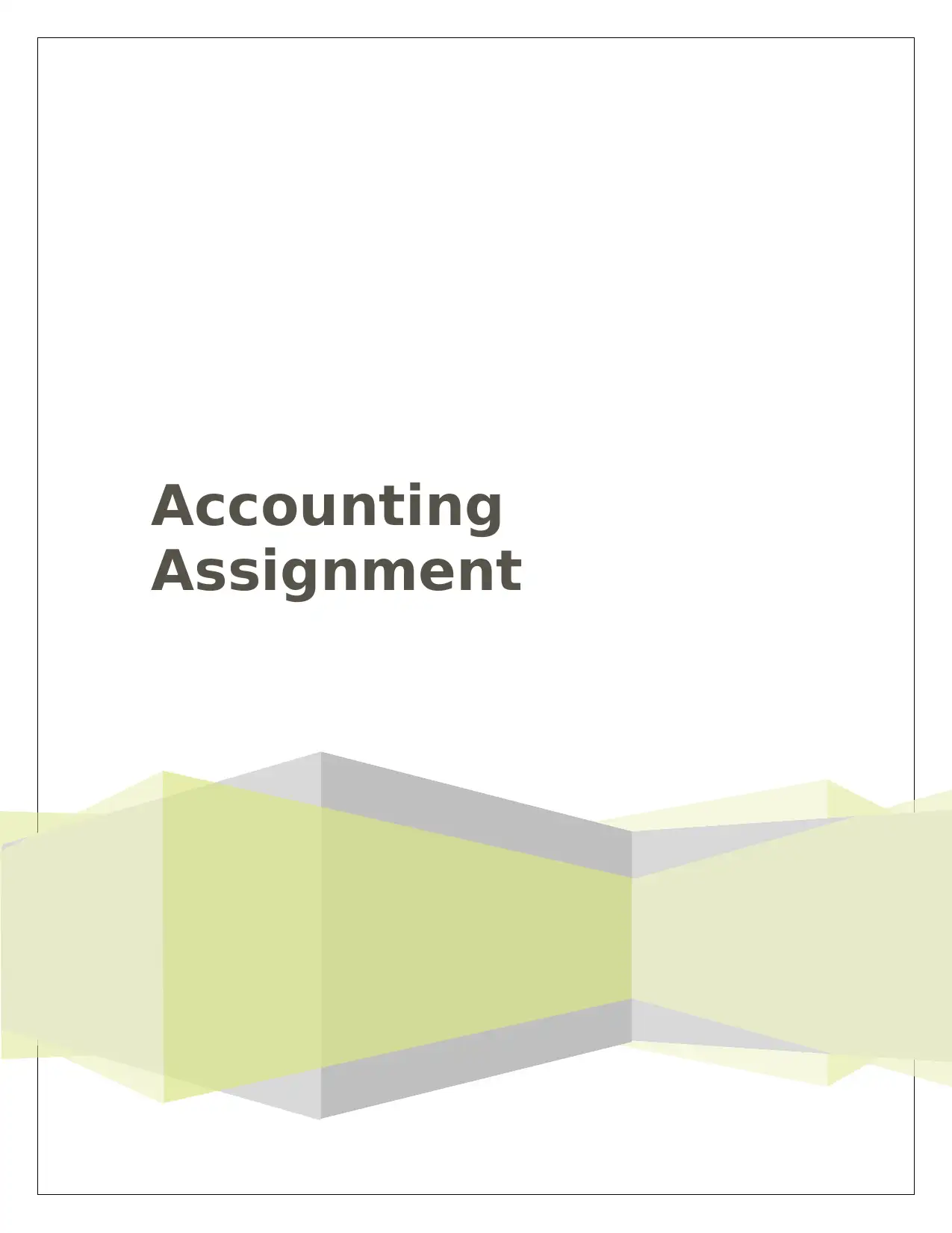
Accounting
Assignment
Assignment
Paraphrase This Document
Need a fresh take? Get an instant paraphrase of this document with our AI Paraphraser
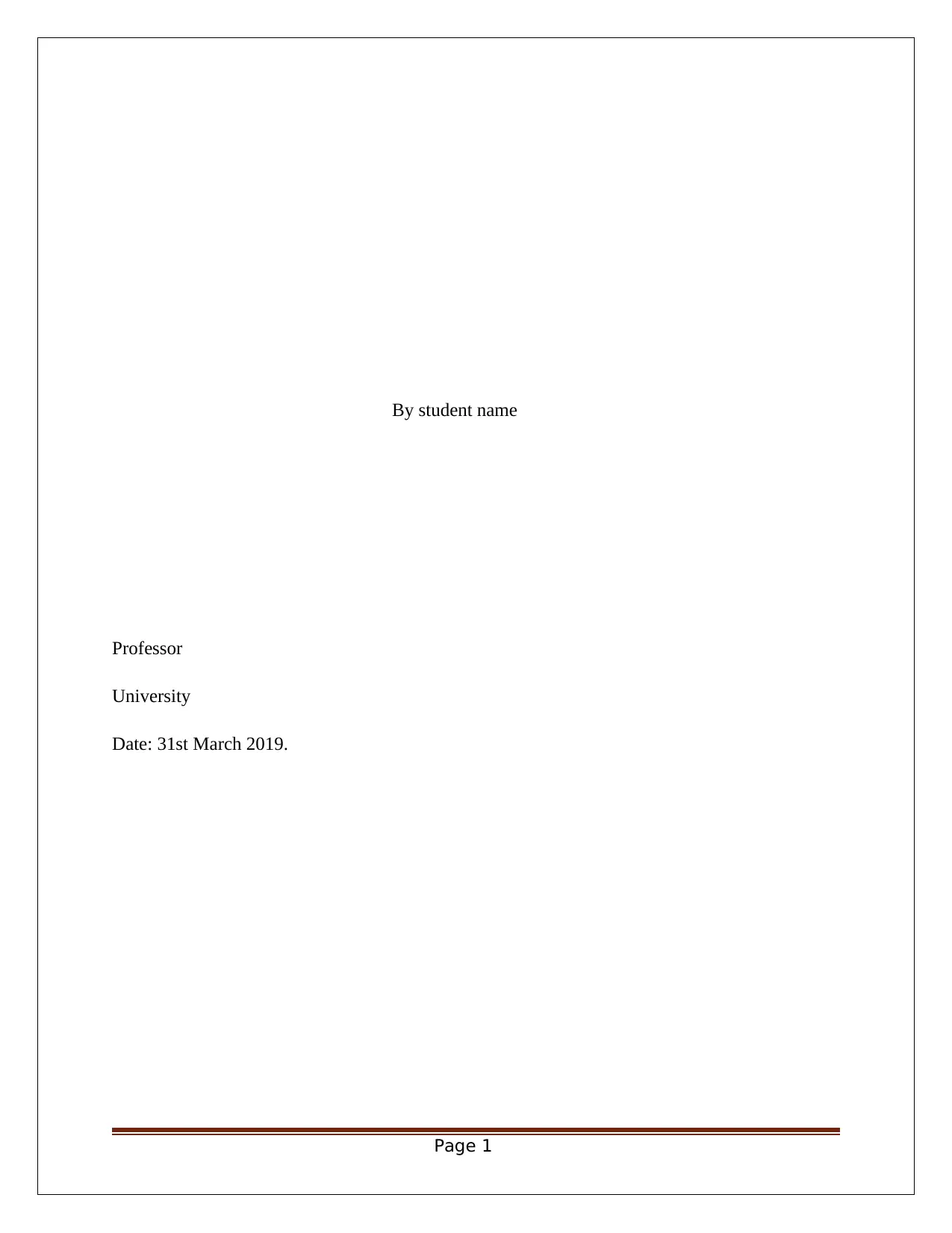
By student name
Professor
University
Date: 31st March 2019.
Page 1
Professor
University
Date: 31st March 2019.
Page 1
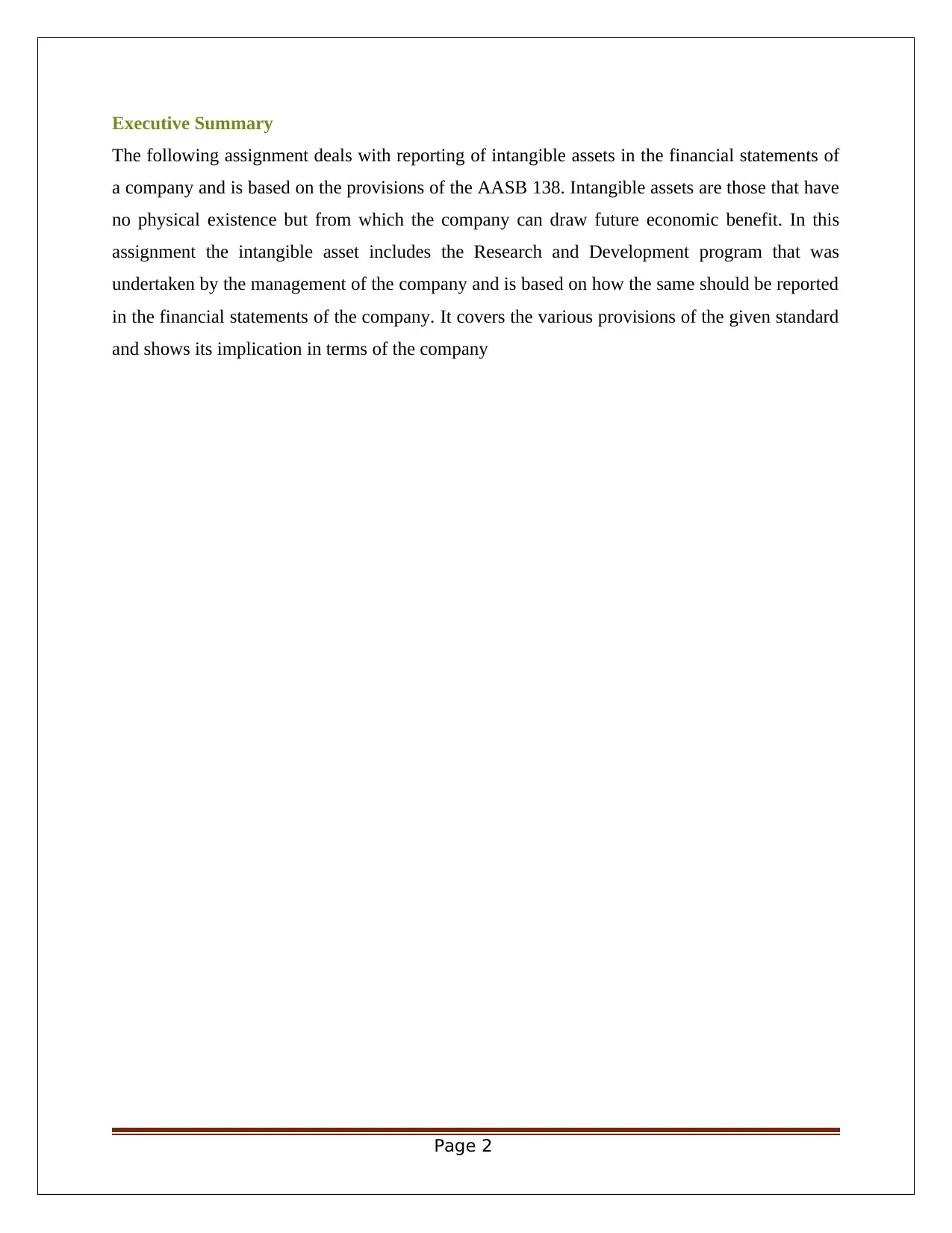
Executive Summary
The following assignment deals with reporting of intangible assets in the financial statements of
a company and is based on the provisions of the AASB 138. Intangible assets are those that have
no physical existence but from which the company can draw future economic benefit. In this
assignment the intangible asset includes the Research and Development program that was
undertaken by the management of the company and is based on how the same should be reported
in the financial statements of the company. It covers the various provisions of the given standard
and shows its implication in terms of the company
Page 2
The following assignment deals with reporting of intangible assets in the financial statements of
a company and is based on the provisions of the AASB 138. Intangible assets are those that have
no physical existence but from which the company can draw future economic benefit. In this
assignment the intangible asset includes the Research and Development program that was
undertaken by the management of the company and is based on how the same should be reported
in the financial statements of the company. It covers the various provisions of the given standard
and shows its implication in terms of the company
Page 2
⊘ This is a preview!⊘
Do you want full access?
Subscribe today to unlock all pages.

Trusted by 1+ million students worldwide
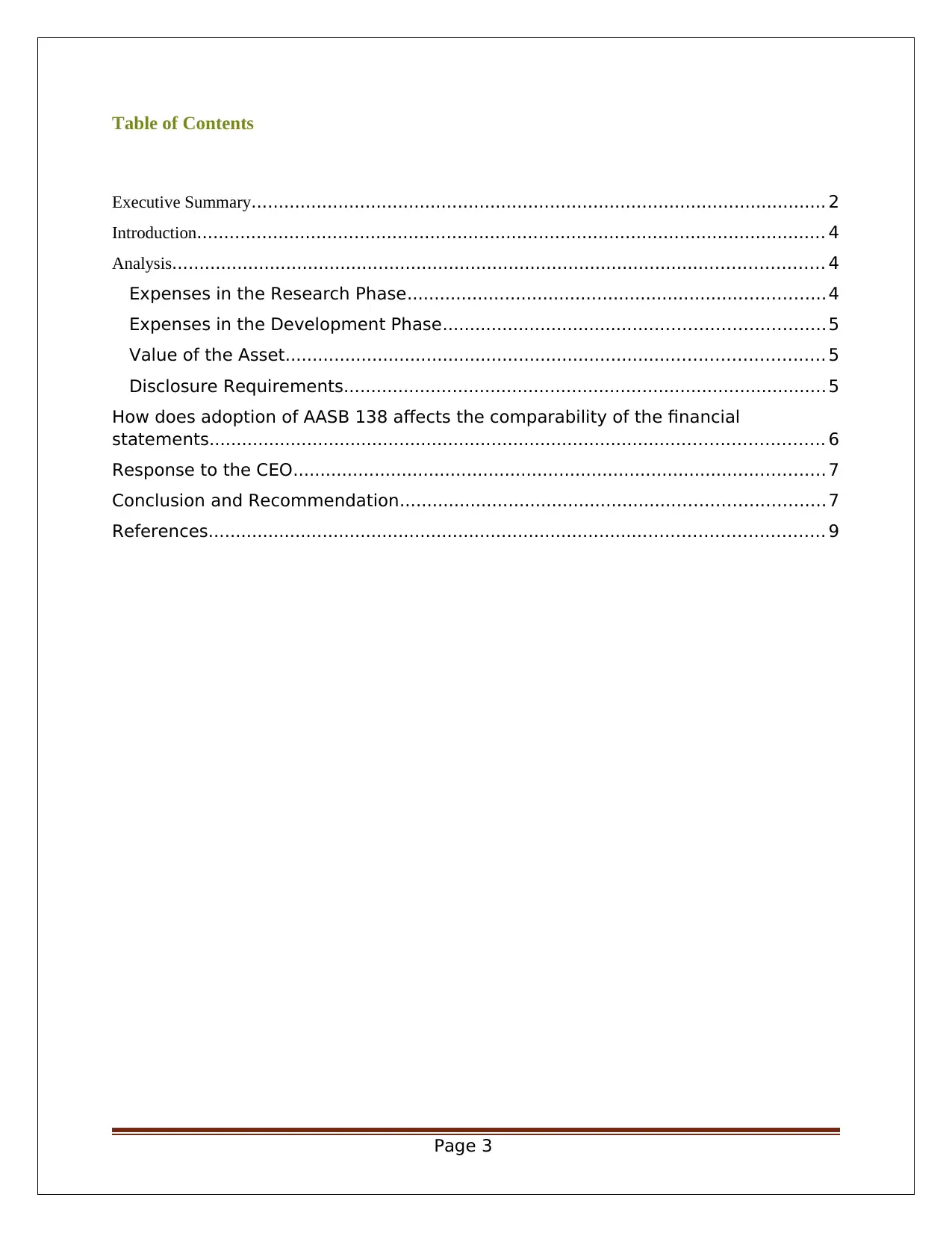
Table of Contents
Executive Summary.......................................................................................................... 2
Introduction.................................................................................................................... 4
Analysis........................................................................................................................ 4
Expenses in the Research Phase.............................................................................4
Expenses in the Development Phase......................................................................5
Value of the Asset................................................................................................... 5
Disclosure Requirements......................................................................................... 5
How does adoption of AASB 138 affects the comparability of the financial
statements................................................................................................................. 6
Response to the CEO.................................................................................................. 7
Conclusion and Recommendation..............................................................................7
References................................................................................................................. 9
Page 3
Executive Summary.......................................................................................................... 2
Introduction.................................................................................................................... 4
Analysis........................................................................................................................ 4
Expenses in the Research Phase.............................................................................4
Expenses in the Development Phase......................................................................5
Value of the Asset................................................................................................... 5
Disclosure Requirements......................................................................................... 5
How does adoption of AASB 138 affects the comparability of the financial
statements................................................................................................................. 6
Response to the CEO.................................................................................................. 7
Conclusion and Recommendation..............................................................................7
References................................................................................................................. 9
Page 3
Paraphrase This Document
Need a fresh take? Get an instant paraphrase of this document with our AI Paraphraser
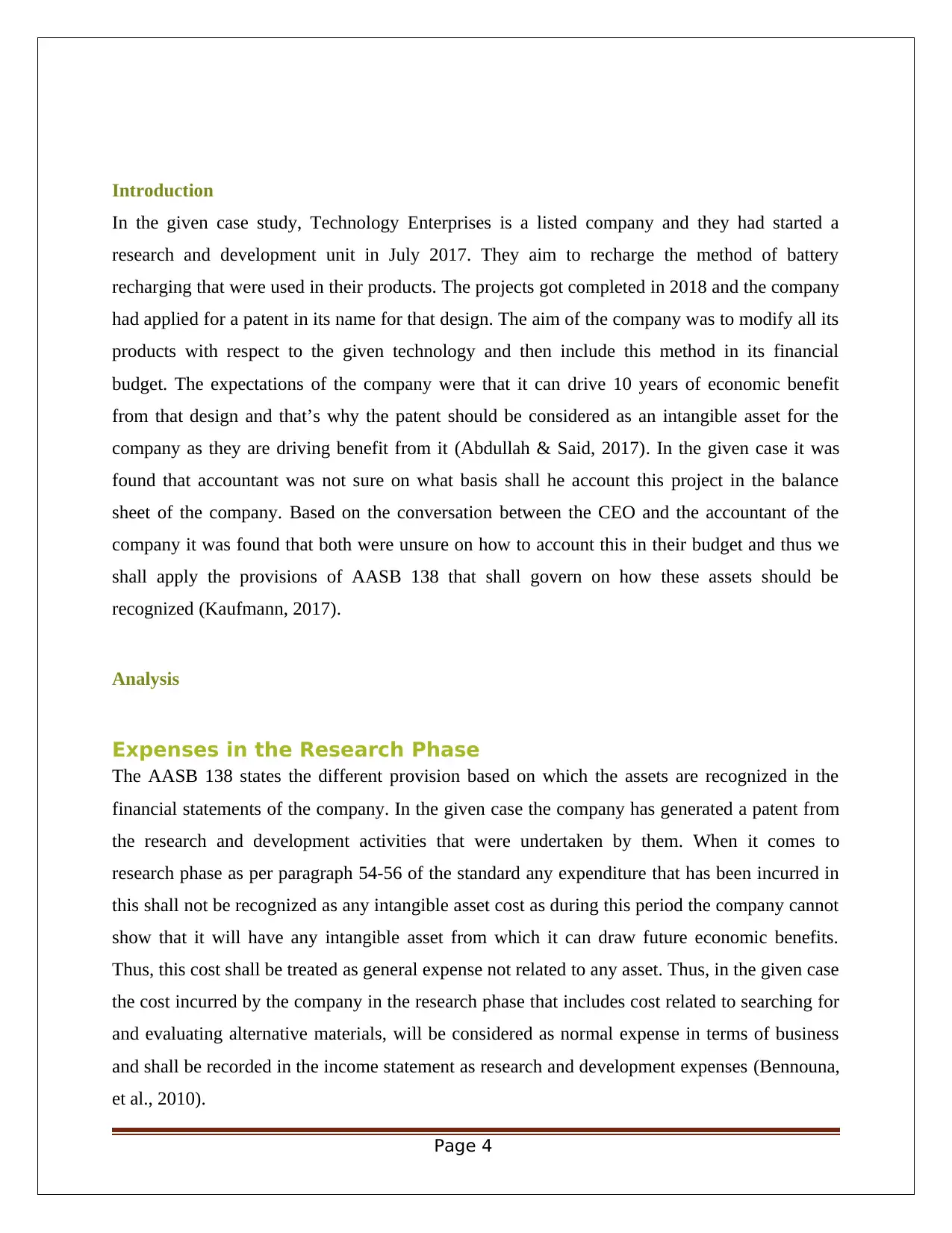
Introduction
In the given case study, Technology Enterprises is a listed company and they had started a
research and development unit in July 2017. They aim to recharge the method of battery
recharging that were used in their products. The projects got completed in 2018 and the company
had applied for a patent in its name for that design. The aim of the company was to modify all its
products with respect to the given technology and then include this method in its financial
budget. The expectations of the company were that it can drive 10 years of economic benefit
from that design and that’s why the patent should be considered as an intangible asset for the
company as they are driving benefit from it (Abdullah & Said, 2017). In the given case it was
found that accountant was not sure on what basis shall he account this project in the balance
sheet of the company. Based on the conversation between the CEO and the accountant of the
company it was found that both were unsure on how to account this in their budget and thus we
shall apply the provisions of AASB 138 that shall govern on how these assets should be
recognized (Kaufmann, 2017).
Analysis
Expenses in the Research Phase
The AASB 138 states the different provision based on which the assets are recognized in the
financial statements of the company. In the given case the company has generated a patent from
the research and development activities that were undertaken by them. When it comes to
research phase as per paragraph 54-56 of the standard any expenditure that has been incurred in
this shall not be recognized as any intangible asset cost as during this period the company cannot
show that it will have any intangible asset from which it can draw future economic benefits.
Thus, this cost shall be treated as general expense not related to any asset. Thus, in the given case
the cost incurred by the company in the research phase that includes cost related to searching for
and evaluating alternative materials, will be considered as normal expense in terms of business
and shall be recorded in the income statement as research and development expenses (Bennouna,
et al., 2010).
Page 4
In the given case study, Technology Enterprises is a listed company and they had started a
research and development unit in July 2017. They aim to recharge the method of battery
recharging that were used in their products. The projects got completed in 2018 and the company
had applied for a patent in its name for that design. The aim of the company was to modify all its
products with respect to the given technology and then include this method in its financial
budget. The expectations of the company were that it can drive 10 years of economic benefit
from that design and that’s why the patent should be considered as an intangible asset for the
company as they are driving benefit from it (Abdullah & Said, 2017). In the given case it was
found that accountant was not sure on what basis shall he account this project in the balance
sheet of the company. Based on the conversation between the CEO and the accountant of the
company it was found that both were unsure on how to account this in their budget and thus we
shall apply the provisions of AASB 138 that shall govern on how these assets should be
recognized (Kaufmann, 2017).
Analysis
Expenses in the Research Phase
The AASB 138 states the different provision based on which the assets are recognized in the
financial statements of the company. In the given case the company has generated a patent from
the research and development activities that were undertaken by them. When it comes to
research phase as per paragraph 54-56 of the standard any expenditure that has been incurred in
this shall not be recognized as any intangible asset cost as during this period the company cannot
show that it will have any intangible asset from which it can draw future economic benefits.
Thus, this cost shall be treated as general expense not related to any asset. Thus, in the given case
the cost incurred by the company in the research phase that includes cost related to searching for
and evaluating alternative materials, will be considered as normal expense in terms of business
and shall be recorded in the income statement as research and development expenses (Bennouna,
et al., 2010).
Page 4
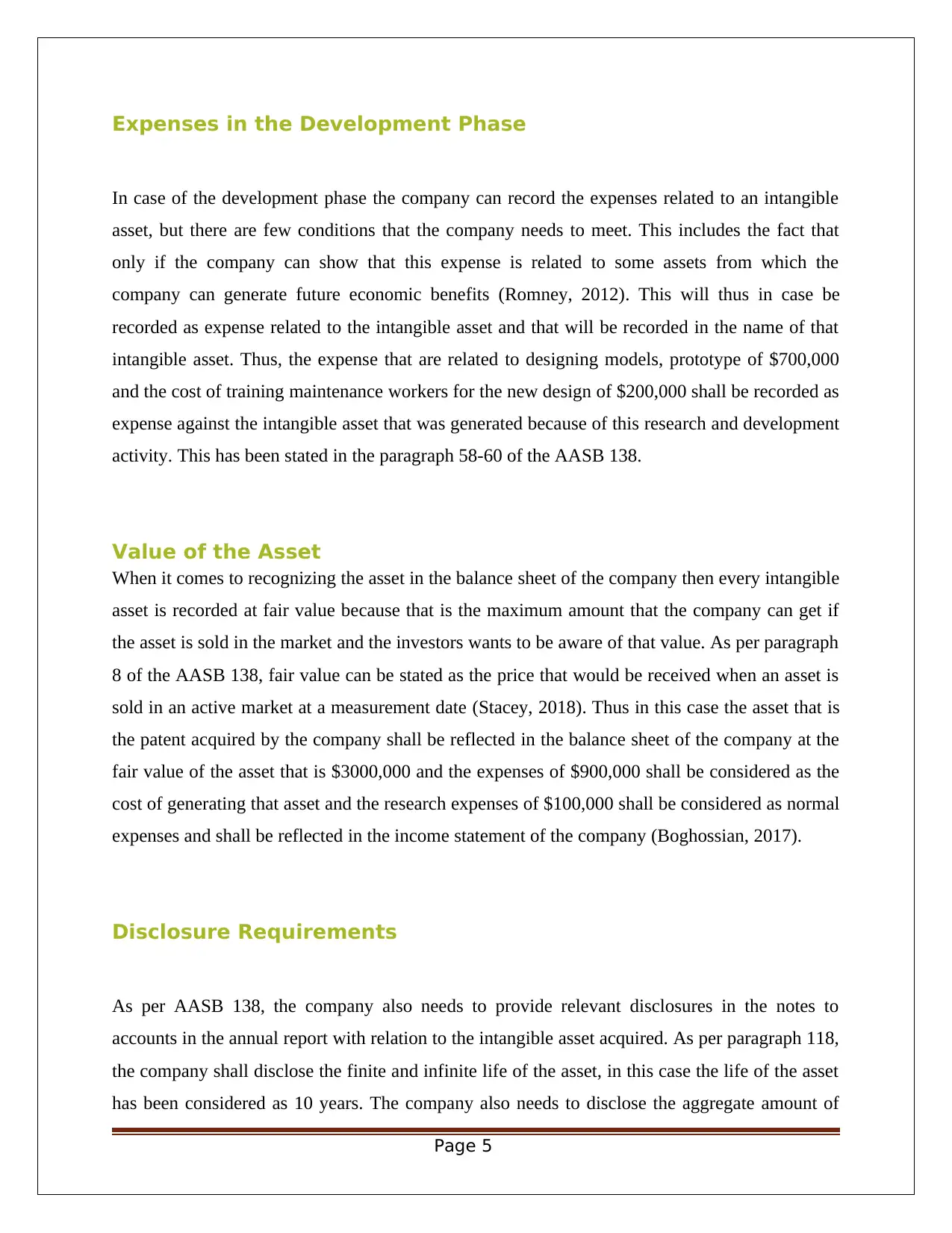
Expenses in the Development Phase
In case of the development phase the company can record the expenses related to an intangible
asset, but there are few conditions that the company needs to meet. This includes the fact that
only if the company can show that this expense is related to some assets from which the
company can generate future economic benefits (Romney, 2012). This will thus in case be
recorded as expense related to the intangible asset and that will be recorded in the name of that
intangible asset. Thus, the expense that are related to designing models, prototype of $700,000
and the cost of training maintenance workers for the new design of $200,000 shall be recorded as
expense against the intangible asset that was generated because of this research and development
activity. This has been stated in the paragraph 58-60 of the AASB 138.
Value of the Asset
When it comes to recognizing the asset in the balance sheet of the company then every intangible
asset is recorded at fair value because that is the maximum amount that the company can get if
the asset is sold in the market and the investors wants to be aware of that value. As per paragraph
8 of the AASB 138, fair value can be stated as the price that would be received when an asset is
sold in an active market at a measurement date (Stacey, 2018). Thus in this case the asset that is
the patent acquired by the company shall be reflected in the balance sheet of the company at the
fair value of the asset that is $3000,000 and the expenses of $900,000 shall be considered as the
cost of generating that asset and the research expenses of $100,000 shall be considered as normal
expenses and shall be reflected in the income statement of the company (Boghossian, 2017).
Disclosure Requirements
As per AASB 138, the company also needs to provide relevant disclosures in the notes to
accounts in the annual report with relation to the intangible asset acquired. As per paragraph 118,
the company shall disclose the finite and infinite life of the asset, in this case the life of the asset
has been considered as 10 years. The company also needs to disclose the aggregate amount of
Page 5
In case of the development phase the company can record the expenses related to an intangible
asset, but there are few conditions that the company needs to meet. This includes the fact that
only if the company can show that this expense is related to some assets from which the
company can generate future economic benefits (Romney, 2012). This will thus in case be
recorded as expense related to the intangible asset and that will be recorded in the name of that
intangible asset. Thus, the expense that are related to designing models, prototype of $700,000
and the cost of training maintenance workers for the new design of $200,000 shall be recorded as
expense against the intangible asset that was generated because of this research and development
activity. This has been stated in the paragraph 58-60 of the AASB 138.
Value of the Asset
When it comes to recognizing the asset in the balance sheet of the company then every intangible
asset is recorded at fair value because that is the maximum amount that the company can get if
the asset is sold in the market and the investors wants to be aware of that value. As per paragraph
8 of the AASB 138, fair value can be stated as the price that would be received when an asset is
sold in an active market at a measurement date (Stacey, 2018). Thus in this case the asset that is
the patent acquired by the company shall be reflected in the balance sheet of the company at the
fair value of the asset that is $3000,000 and the expenses of $900,000 shall be considered as the
cost of generating that asset and the research expenses of $100,000 shall be considered as normal
expenses and shall be reflected in the income statement of the company (Boghossian, 2017).
Disclosure Requirements
As per AASB 138, the company also needs to provide relevant disclosures in the notes to
accounts in the annual report with relation to the intangible asset acquired. As per paragraph 118,
the company shall disclose the finite and infinite life of the asset, in this case the life of the asset
has been considered as 10 years. The company also needs to disclose the aggregate amount of
Page 5
⊘ This is a preview!⊘
Do you want full access?
Subscribe today to unlock all pages.

Trusted by 1+ million students worldwide
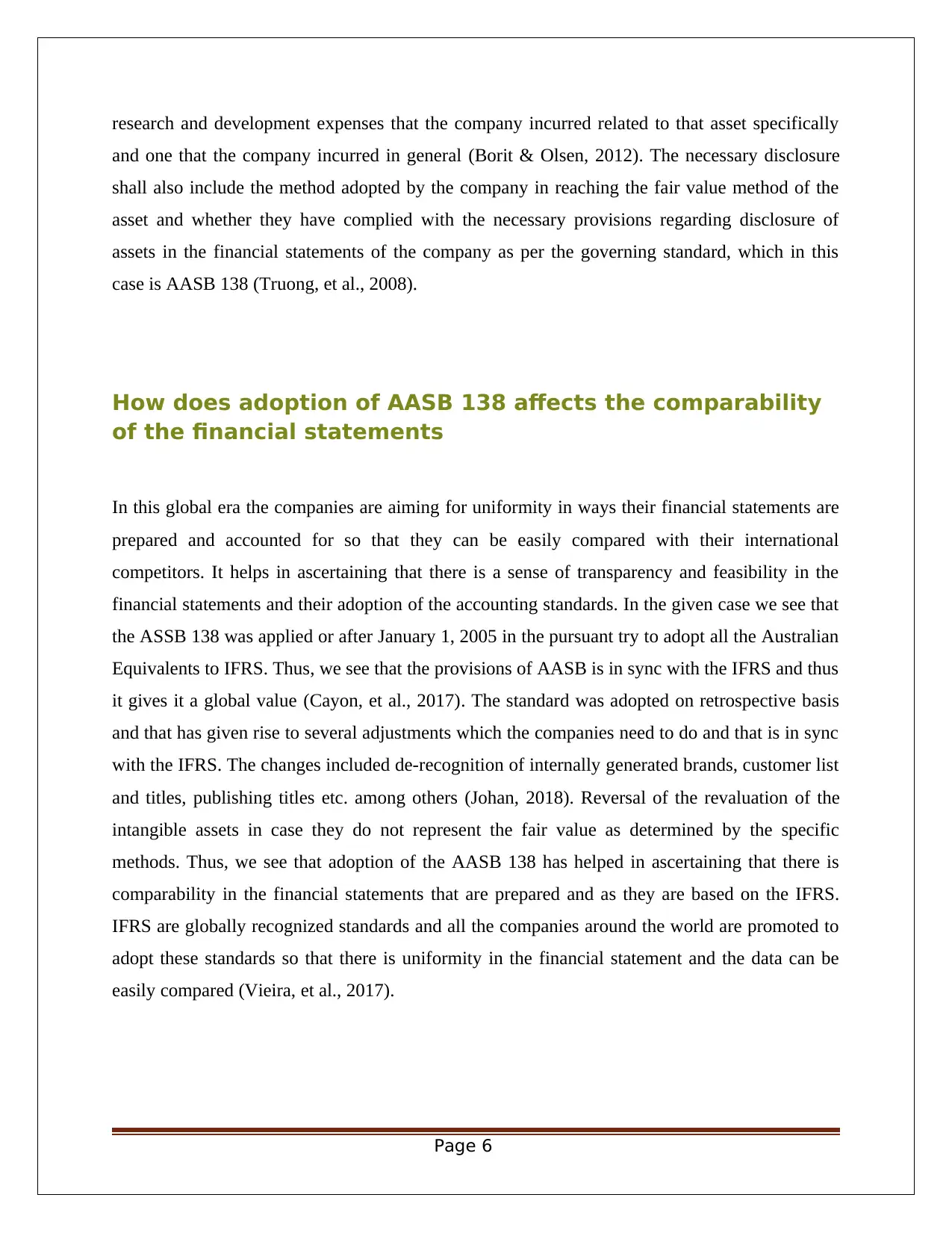
research and development expenses that the company incurred related to that asset specifically
and one that the company incurred in general (Borit & Olsen, 2012). The necessary disclosure
shall also include the method adopted by the company in reaching the fair value method of the
asset and whether they have complied with the necessary provisions regarding disclosure of
assets in the financial statements of the company as per the governing standard, which in this
case is AASB 138 (Truong, et al., 2008).
How does adoption of AASB 138 affects the comparability
of the financial statements
In this global era the companies are aiming for uniformity in ways their financial statements are
prepared and accounted for so that they can be easily compared with their international
competitors. It helps in ascertaining that there is a sense of transparency and feasibility in the
financial statements and their adoption of the accounting standards. In the given case we see that
the ASSB 138 was applied or after January 1, 2005 in the pursuant try to adopt all the Australian
Equivalents to IFRS. Thus, we see that the provisions of AASB is in sync with the IFRS and thus
it gives it a global value (Cayon, et al., 2017). The standard was adopted on retrospective basis
and that has given rise to several adjustments which the companies need to do and that is in sync
with the IFRS. The changes included de-recognition of internally generated brands, customer list
and titles, publishing titles etc. among others (Johan, 2018). Reversal of the revaluation of the
intangible assets in case they do not represent the fair value as determined by the specific
methods. Thus, we see that adoption of the AASB 138 has helped in ascertaining that there is
comparability in the financial statements that are prepared and as they are based on the IFRS.
IFRS are globally recognized standards and all the companies around the world are promoted to
adopt these standards so that there is uniformity in the financial statement and the data can be
easily compared (Vieira, et al., 2017).
Page 6
and one that the company incurred in general (Borit & Olsen, 2012). The necessary disclosure
shall also include the method adopted by the company in reaching the fair value method of the
asset and whether they have complied with the necessary provisions regarding disclosure of
assets in the financial statements of the company as per the governing standard, which in this
case is AASB 138 (Truong, et al., 2008).
How does adoption of AASB 138 affects the comparability
of the financial statements
In this global era the companies are aiming for uniformity in ways their financial statements are
prepared and accounted for so that they can be easily compared with their international
competitors. It helps in ascertaining that there is a sense of transparency and feasibility in the
financial statements and their adoption of the accounting standards. In the given case we see that
the ASSB 138 was applied or after January 1, 2005 in the pursuant try to adopt all the Australian
Equivalents to IFRS. Thus, we see that the provisions of AASB is in sync with the IFRS and thus
it gives it a global value (Cayon, et al., 2017). The standard was adopted on retrospective basis
and that has given rise to several adjustments which the companies need to do and that is in sync
with the IFRS. The changes included de-recognition of internally generated brands, customer list
and titles, publishing titles etc. among others (Johan, 2018). Reversal of the revaluation of the
intangible assets in case they do not represent the fair value as determined by the specific
methods. Thus, we see that adoption of the AASB 138 has helped in ascertaining that there is
comparability in the financial statements that are prepared and as they are based on the IFRS.
IFRS are globally recognized standards and all the companies around the world are promoted to
adopt these standards so that there is uniformity in the financial statement and the data can be
easily compared (Vieira, et al., 2017).
Page 6
Paraphrase This Document
Need a fresh take? Get an instant paraphrase of this document with our AI Paraphraser
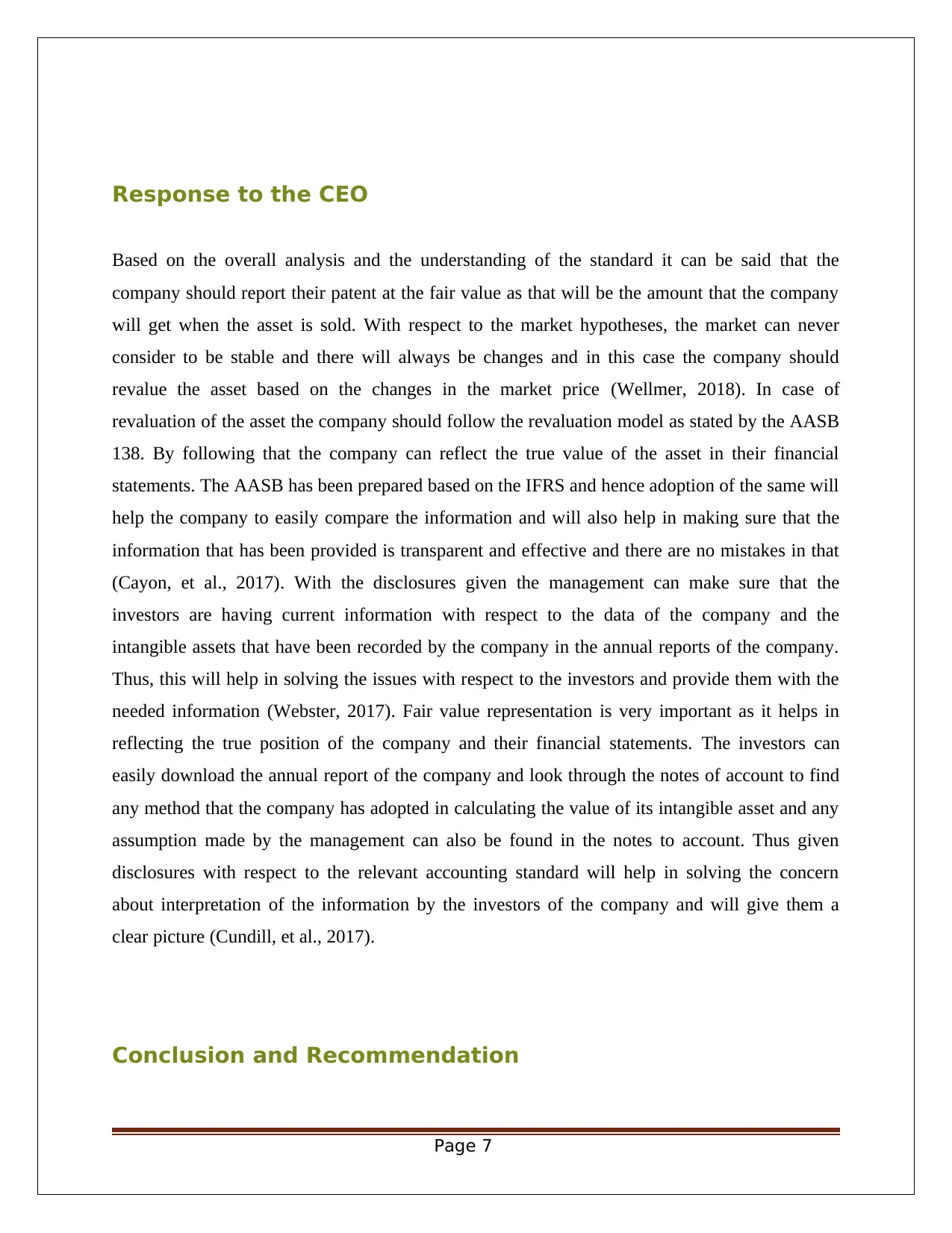
Response to the CEO
Based on the overall analysis and the understanding of the standard it can be said that the
company should report their patent at the fair value as that will be the amount that the company
will get when the asset is sold. With respect to the market hypotheses, the market can never
consider to be stable and there will always be changes and in this case the company should
revalue the asset based on the changes in the market price (Wellmer, 2018). In case of
revaluation of the asset the company should follow the revaluation model as stated by the AASB
138. By following that the company can reflect the true value of the asset in their financial
statements. The AASB has been prepared based on the IFRS and hence adoption of the same will
help the company to easily compare the information and will also help in making sure that the
information that has been provided is transparent and effective and there are no mistakes in that
(Cayon, et al., 2017). With the disclosures given the management can make sure that the
investors are having current information with respect to the data of the company and the
intangible assets that have been recorded by the company in the annual reports of the company.
Thus, this will help in solving the issues with respect to the investors and provide them with the
needed information (Webster, 2017). Fair value representation is very important as it helps in
reflecting the true position of the company and their financial statements. The investors can
easily download the annual report of the company and look through the notes of account to find
any method that the company has adopted in calculating the value of its intangible asset and any
assumption made by the management can also be found in the notes to account. Thus given
disclosures with respect to the relevant accounting standard will help in solving the concern
about interpretation of the information by the investors of the company and will give them a
clear picture (Cundill, et al., 2017).
Conclusion and Recommendation
Page 7
Based on the overall analysis and the understanding of the standard it can be said that the
company should report their patent at the fair value as that will be the amount that the company
will get when the asset is sold. With respect to the market hypotheses, the market can never
consider to be stable and there will always be changes and in this case the company should
revalue the asset based on the changes in the market price (Wellmer, 2018). In case of
revaluation of the asset the company should follow the revaluation model as stated by the AASB
138. By following that the company can reflect the true value of the asset in their financial
statements. The AASB has been prepared based on the IFRS and hence adoption of the same will
help the company to easily compare the information and will also help in making sure that the
information that has been provided is transparent and effective and there are no mistakes in that
(Cayon, et al., 2017). With the disclosures given the management can make sure that the
investors are having current information with respect to the data of the company and the
intangible assets that have been recorded by the company in the annual reports of the company.
Thus, this will help in solving the issues with respect to the investors and provide them with the
needed information (Webster, 2017). Fair value representation is very important as it helps in
reflecting the true position of the company and their financial statements. The investors can
easily download the annual report of the company and look through the notes of account to find
any method that the company has adopted in calculating the value of its intangible asset and any
assumption made by the management can also be found in the notes to account. Thus given
disclosures with respect to the relevant accounting standard will help in solving the concern
about interpretation of the information by the investors of the company and will give them a
clear picture (Cundill, et al., 2017).
Conclusion and Recommendation
Page 7
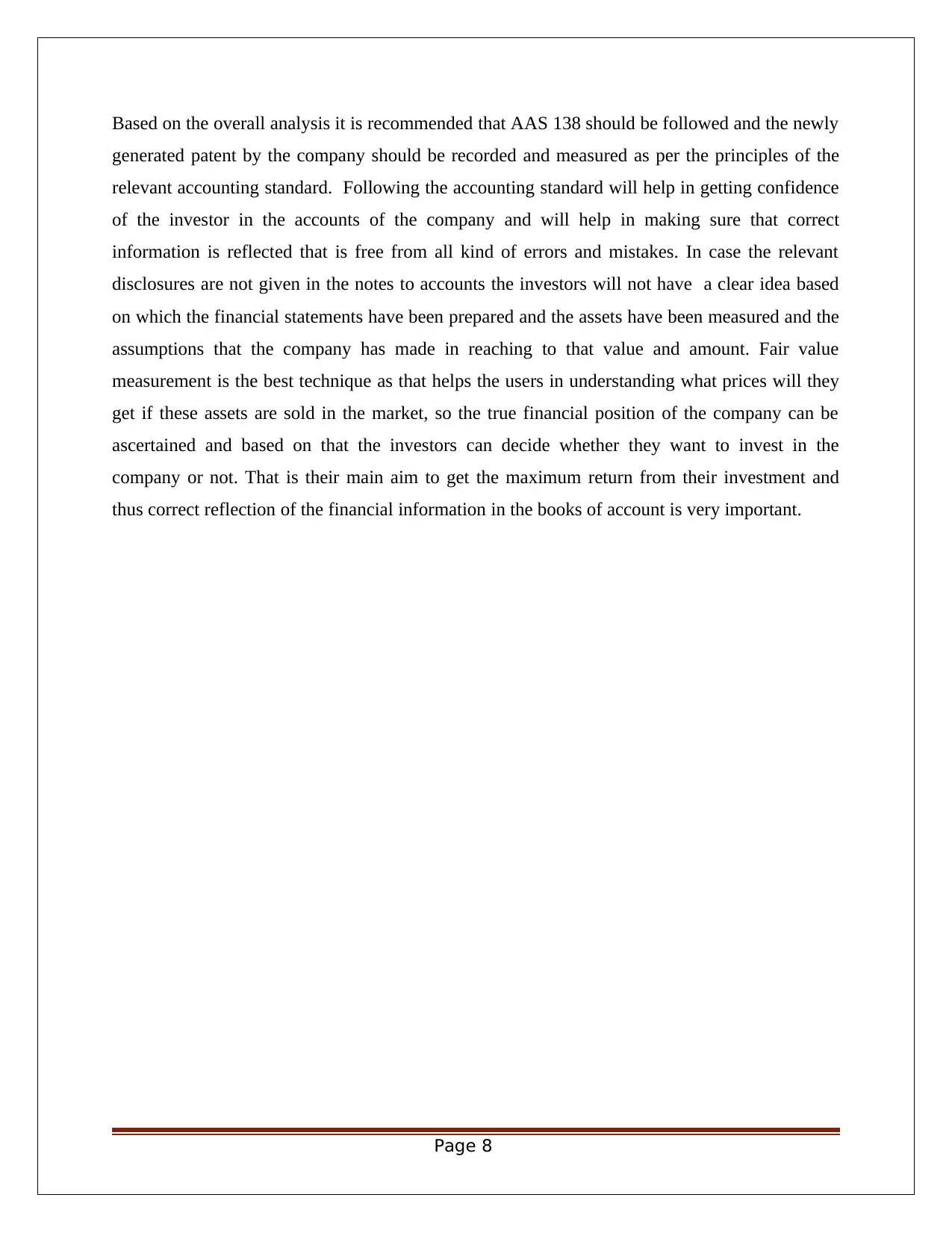
Based on the overall analysis it is recommended that AAS 138 should be followed and the newly
generated patent by the company should be recorded and measured as per the principles of the
relevant accounting standard. Following the accounting standard will help in getting confidence
of the investor in the accounts of the company and will help in making sure that correct
information is reflected that is free from all kind of errors and mistakes. In case the relevant
disclosures are not given in the notes to accounts the investors will not have a clear idea based
on which the financial statements have been prepared and the assets have been measured and the
assumptions that the company has made in reaching to that value and amount. Fair value
measurement is the best technique as that helps the users in understanding what prices will they
get if these assets are sold in the market, so the true financial position of the company can be
ascertained and based on that the investors can decide whether they want to invest in the
company or not. That is their main aim to get the maximum return from their investment and
thus correct reflection of the financial information in the books of account is very important.
Page 8
generated patent by the company should be recorded and measured as per the principles of the
relevant accounting standard. Following the accounting standard will help in getting confidence
of the investor in the accounts of the company and will help in making sure that correct
information is reflected that is free from all kind of errors and mistakes. In case the relevant
disclosures are not given in the notes to accounts the investors will not have a clear idea based
on which the financial statements have been prepared and the assets have been measured and the
assumptions that the company has made in reaching to that value and amount. Fair value
measurement is the best technique as that helps the users in understanding what prices will they
get if these assets are sold in the market, so the true financial position of the company can be
ascertained and based on that the investors can decide whether they want to invest in the
company or not. That is their main aim to get the maximum return from their investment and
thus correct reflection of the financial information in the books of account is very important.
Page 8
⊘ This is a preview!⊘
Do you want full access?
Subscribe today to unlock all pages.

Trusted by 1+ million students worldwide
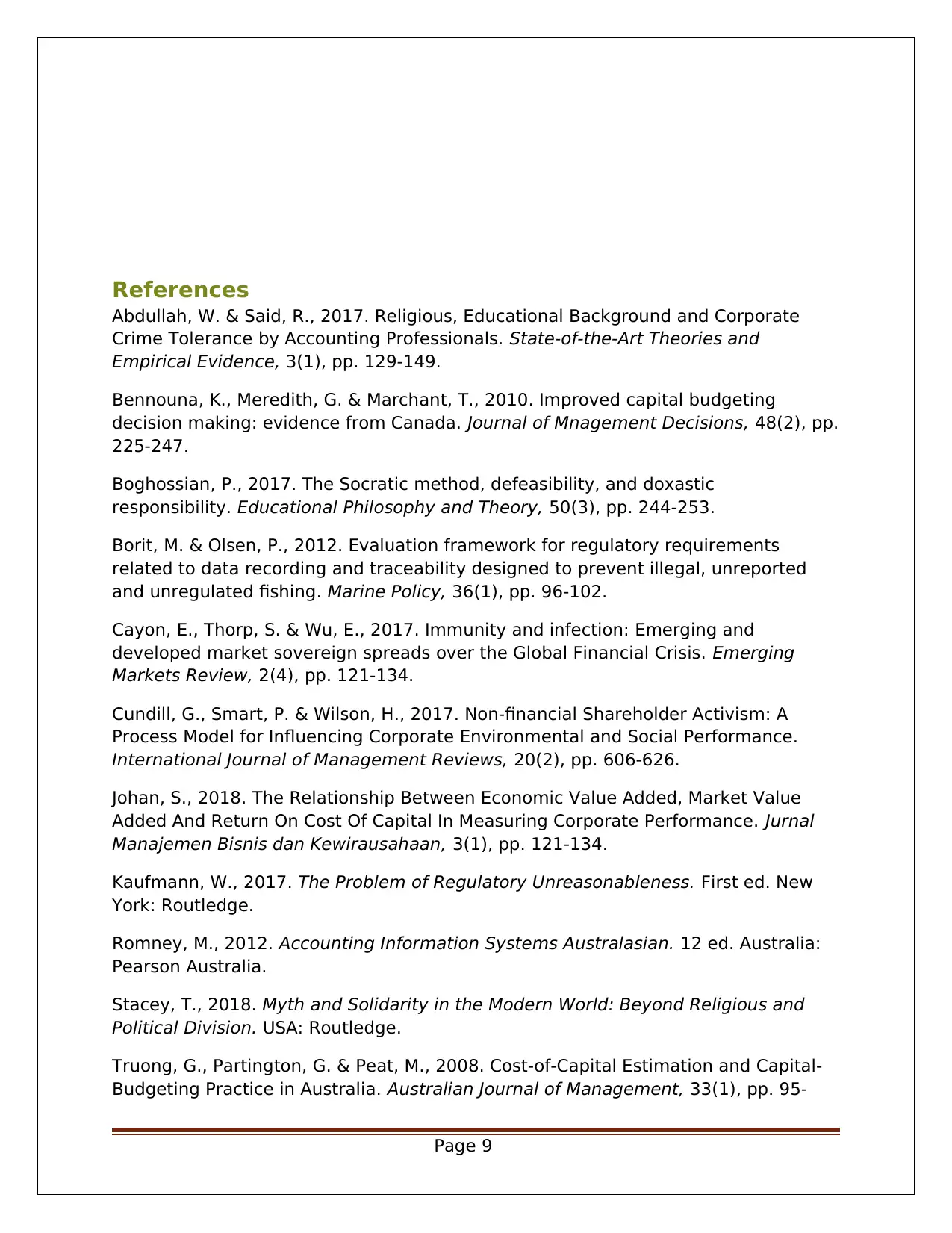
References
Abdullah, W. & Said, R., 2017. Religious, Educational Background and Corporate
Crime Tolerance by Accounting Professionals. State-of-the-Art Theories and
Empirical Evidence, 3(1), pp. 129-149.
Bennouna, K., Meredith, G. & Marchant, T., 2010. Improved capital budgeting
decision making: evidence from Canada. Journal of Mnagement Decisions, 48(2), pp.
225-247.
Boghossian, P., 2017. The Socratic method, defeasibility, and doxastic
responsibility. Educational Philosophy and Theory, 50(3), pp. 244-253.
Borit, M. & Olsen, P., 2012. Evaluation framework for regulatory requirements
related to data recording and traceability designed to prevent illegal, unreported
and unregulated fishing. Marine Policy, 36(1), pp. 96-102.
Cayon, E., Thorp, S. & Wu, E., 2017. Immunity and infection: Emerging and
developed market sovereign spreads over the Global Financial Crisis. Emerging
Markets Review, 2(4), pp. 121-134.
Cundill, G., Smart, P. & Wilson, H., 2017. Non‐financial Shareholder Activism: A
Process Model for Influencing Corporate Environmental and Social Performance.
International Journal of Management Reviews, 20(2), pp. 606-626.
Johan, S., 2018. The Relationship Between Economic Value Added, Market Value
Added And Return On Cost Of Capital In Measuring Corporate Performance. Jurnal
Manajemen Bisnis dan Kewirausahaan, 3(1), pp. 121-134.
Kaufmann, W., 2017. The Problem of Regulatory Unreasonableness. First ed. New
York: Routledge.
Romney, M., 2012. Accounting Information Systems Australasian. 12 ed. Australia:
Pearson Australia.
Stacey, T., 2018. Myth and Solidarity in the Modern World: Beyond Religious and
Political Division. USA: Routledge.
Truong, G., Partington, G. & Peat, M., 2008. Cost-of-Capital Estimation and Capital-
Budgeting Practice in Australia. Australian Journal of Management, 33(1), pp. 95-
Page 9
Abdullah, W. & Said, R., 2017. Religious, Educational Background and Corporate
Crime Tolerance by Accounting Professionals. State-of-the-Art Theories and
Empirical Evidence, 3(1), pp. 129-149.
Bennouna, K., Meredith, G. & Marchant, T., 2010. Improved capital budgeting
decision making: evidence from Canada. Journal of Mnagement Decisions, 48(2), pp.
225-247.
Boghossian, P., 2017. The Socratic method, defeasibility, and doxastic
responsibility. Educational Philosophy and Theory, 50(3), pp. 244-253.
Borit, M. & Olsen, P., 2012. Evaluation framework for regulatory requirements
related to data recording and traceability designed to prevent illegal, unreported
and unregulated fishing. Marine Policy, 36(1), pp. 96-102.
Cayon, E., Thorp, S. & Wu, E., 2017. Immunity and infection: Emerging and
developed market sovereign spreads over the Global Financial Crisis. Emerging
Markets Review, 2(4), pp. 121-134.
Cundill, G., Smart, P. & Wilson, H., 2017. Non‐financial Shareholder Activism: A
Process Model for Influencing Corporate Environmental and Social Performance.
International Journal of Management Reviews, 20(2), pp. 606-626.
Johan, S., 2018. The Relationship Between Economic Value Added, Market Value
Added And Return On Cost Of Capital In Measuring Corporate Performance. Jurnal
Manajemen Bisnis dan Kewirausahaan, 3(1), pp. 121-134.
Kaufmann, W., 2017. The Problem of Regulatory Unreasonableness. First ed. New
York: Routledge.
Romney, M., 2012. Accounting Information Systems Australasian. 12 ed. Australia:
Pearson Australia.
Stacey, T., 2018. Myth and Solidarity in the Modern World: Beyond Religious and
Political Division. USA: Routledge.
Truong, G., Partington, G. & Peat, M., 2008. Cost-of-Capital Estimation and Capital-
Budgeting Practice in Australia. Australian Journal of Management, 33(1), pp. 95-
Page 9
Paraphrase This Document
Need a fresh take? Get an instant paraphrase of this document with our AI Paraphraser
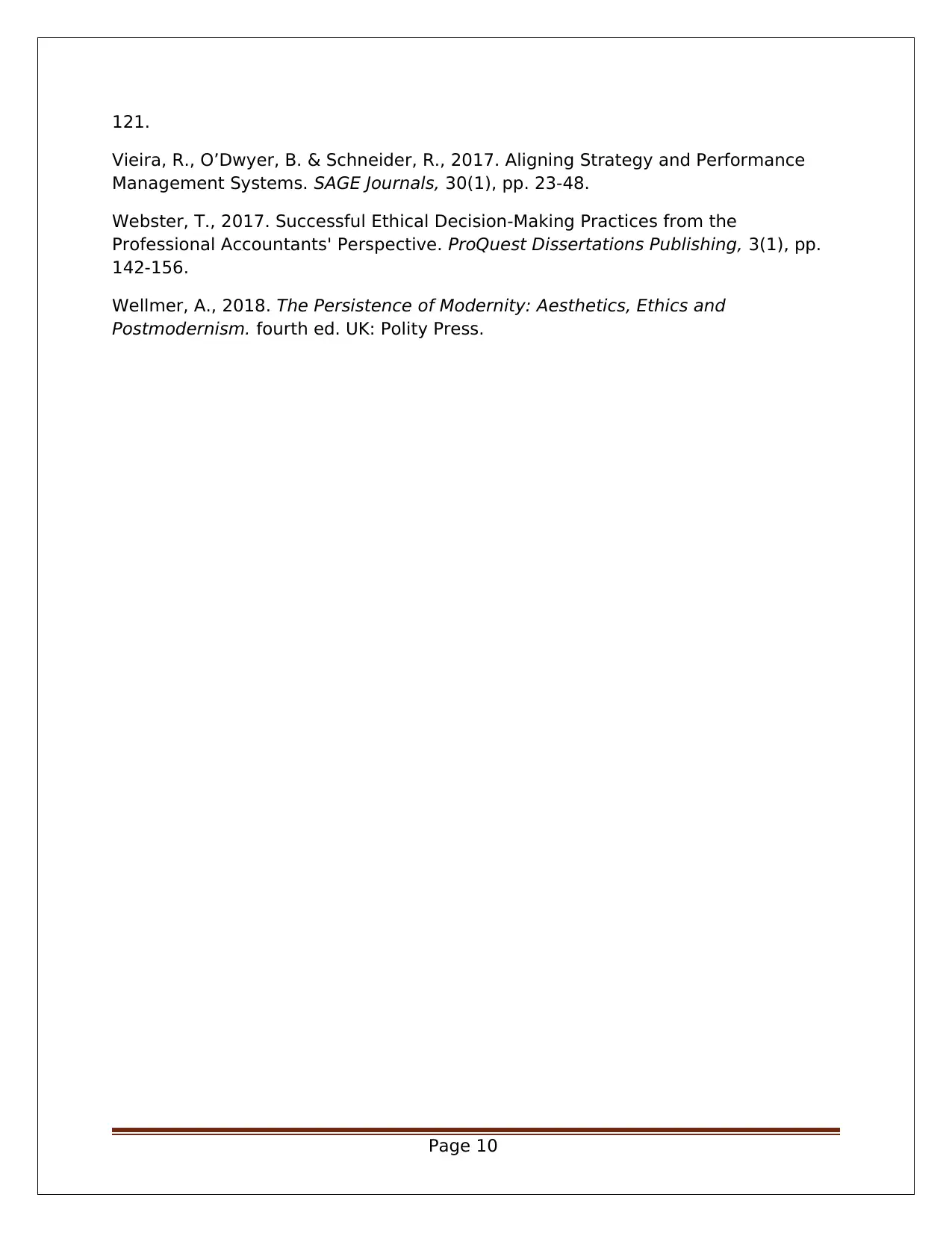
121.
Vieira, R., O’Dwyer, B. & Schneider, R., 2017. Aligning Strategy and Performance
Management Systems. SAGE Journals, 30(1), pp. 23-48.
Webster, T., 2017. Successful Ethical Decision-Making Practices from the
Professional Accountants' Perspective. ProQuest Dissertations Publishing, 3(1), pp.
142-156.
Wellmer, A., 2018. The Persistence of Modernity: Aesthetics, Ethics and
Postmodernism. fourth ed. UK: Polity Press.
Page 10
Vieira, R., O’Dwyer, B. & Schneider, R., 2017. Aligning Strategy and Performance
Management Systems. SAGE Journals, 30(1), pp. 23-48.
Webster, T., 2017. Successful Ethical Decision-Making Practices from the
Professional Accountants' Perspective. ProQuest Dissertations Publishing, 3(1), pp.
142-156.
Wellmer, A., 2018. The Persistence of Modernity: Aesthetics, Ethics and
Postmodernism. fourth ed. UK: Polity Press.
Page 10
1 out of 11
Related Documents
Your All-in-One AI-Powered Toolkit for Academic Success.
+13062052269
info@desklib.com
Available 24*7 on WhatsApp / Email
![[object Object]](/_next/static/media/star-bottom.7253800d.svg)
Unlock your academic potential
Copyright © 2020–2025 A2Z Services. All Rights Reserved. Developed and managed by ZUCOL.





